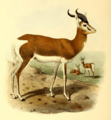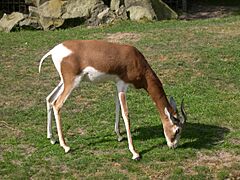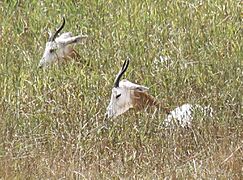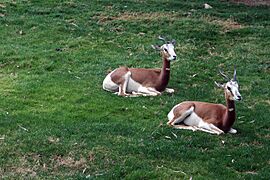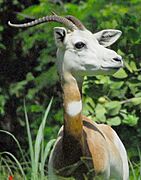Addra gazelle facts for kids
Quick facts for kids Dama gazelle |
|
|---|---|
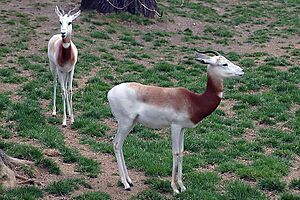 |
|
| An Addra gazelle (N. d. ruficollis) at Maryland Zoo | |
 |
|
| A Mhorr gazelle (N. d. mhorr) at Louisville Zoo | |
| Conservation status | |
| Scientific classification | |
| Genus: |
Nanger
|
| Species: |
dama
|
| Subspecies | |
also see text |
|
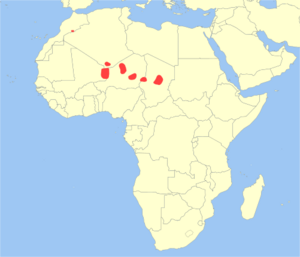 |
|
| Where Dama gazelles live | |
| Synonyms | |
|
|
The dama gazelle (Nanger dama) is a type of gazelle. It is also called the addra gazelle or mhorr gazelle. These animals live in Africa, specifically in the Sahara desert and the Sahel region.
Sadly, the dama gazelle is a critically endangered species. This means it is very close to disappearing forever. It has vanished from many places where it used to live. This is mainly because of too much hunting and losing its natural home. Today, wild dama gazelles are only found in Chad, Mali, and Niger.
Their homes include grasslands, areas with shrubs, semi-deserts, open savannas, and mountain plateaus. They eat shrubs, herbs, grasses, leaves (especially Acacia leaves), young shoots, and fruit. In Niger, the dama gazelle is a national symbol. It appears on the badge of the Niger national football team, who are known as the Ménas.
Contents
What Does a Dama Gazelle Look Like?
The dama gazelle has a white body with a reddish-brown head and neck. Both male and female gazelles usually have medium-sized horns. These horns are ringed and curve like an "S" shape. Male horns are about 35 centimeters (14 inches) long. Female horns are much shorter.
Their heads are small with a narrow nose area, and their eyes are quite large. Dama gazelles have longer necks and legs than most other gazelles. They stand between 90 and 95 centimeters (35 to 37 inches) tall at the shoulder. They weigh between 35 and 75 kilograms (77 to 165 pounds).
In the wild, they can live up to 12 years. In zoos, they can live up to 18 years. Just a few days after being born, young dama gazelles are strong enough to follow their herd. After about a week, they can run as fast as the adult gazelles.
The dama gazelle is the largest type of gazelle. Its very long legs help it stay cool in the hot desert. The extra surface area helps heat escape from its body. Dama gazelles need more water than some other desert animals. However, they can still survive long dry periods.
Unlike many other desert animals, the dama gazelle is active during the day. This means it is a diurnal species. They are always alert for danger. If they sense a threat, they use a special behavior called pronking. This warns other gazelles in the herd. Pronking means the animal hops up and down with all four legs stiff. All its limbs leave and touch the ground at the same time.
Male gazelles also create their own territories. During breeding season, they keep other adult males away from their area. They mark their territories using urine, piles of dung, and special liquids from glands near their eyes.
Different Types of Dama Gazelles
Dama gazelles are usually divided into three main types, called subspecies. These types are based on the color of their back, sides, and rear. Each subspecies used to live in a different area across the gazelle's range.
- The N. d. ruficollis (called the addra gazelle) lived in the eastern part of their range.
- The N. d. mhorr (called the mhorr gazelle) lived in the western part.
- The N. d. dama lived in the middle.
Scientists have studied their genes. These studies suggest that the color differences might just be gradual changes across their range. This means the subspecies might not be as distinct as once thought.
- The N. d. mhorr, or mhorr gazelle, is now extinct in the wild. This means it no longer lives freely in nature. The last wild sighting was in 1968. However, mhorr gazelles are part of special breeding programs in zoos. These programs are in Europe, North America, North Africa, and the Middle East. Some have even been released back into areas where they used to live.
- The N. d. dama is very rare in the wild. It is mainly kept in captivity at Al Ain Zoo in the United Arab Emirates.
- The N. d. ruficollis, or addra gazelle, is also very rare in the wild. It is part of captive breeding programs in Europe, North America, and the Middle East.
The number of dama gazelles in the wild has dropped by 80% in the last ten years. The IUCN (International Union for Conservation of Nature) now lists them as critically endangered. There are fewer than 500 wild dama gazelles left, possibly around 300.
These gazelles live in countries that often struggle with poverty. Because of this, not much is done to protect them. National parks are not well-guarded, and illegal hunting (poaching) still happens. Dama gazelles have disappeared completely from Libya, Mauritania, Morocco, and Nigeria. Small groups still live in Chad, Mali, and Niger. They have also been brought back to Senegal and Tunisia.
Why Are Dama Gazelles in Danger?
Natural Challenges
Dama gazelles need more water than some other desert animals. They can die from lack of water during dry seasons. Their natural home has also become harder for them to live in. Farming and grazing animals like cows and goats take up space and resources. Diseases from farm animals can also spread to the gazelles.
Human Challenges
Humans are the biggest threat to the dama gazelle. One major problem is habitat destruction. People cut down tree branches that these gazelles eat. This kills the trees, leaving the gazelles without food.
The main reason this gazelle is endangered is because of hunting with vehicles. Hunters use cars to chase and catch them, which makes it much easier to hunt them. This has greatly reduced their numbers. Problems like civil unrest, for example in Sudan, also make life harder for the dama gazelle. When their homes are already difficult, these conditions make it almost impossible to survive.
Tourism can also be a problem. Tourists want to take pictures of these rare animals. But if gazelles feel threatened, they will run away. In the hot season, running too much can cause them to overheat and die from stress.
Helping Dama Gazelles Survive
Not many actions have been taken to save the dama gazelle. The main efforts include creating reserves and captive breeding programs. Reserves are safe places where the animals can live peacefully. Captive breeding helps increase their numbers by having them reproduce in zoos.
A special reserve for mhorr gazelles was started in 1971 in Spain. It is called the Rescue Park for Saharan Fauna. This reserve has been very successful and still exists today. Another reserve was set up in Chad in 1978. However, it was abandoned in 1987 due to civil war.
Captive breeding is a popular way to help endangered species. The gazelles reproduce in zoos, but there is a challenge. If the first group of animals is too small, it can lead to inbreeding. This means animals that are too closely related breed together.
Zoos in Europe mainly focus on the mhorr gazelle (N. d. mhorr). Zoos in North America mainly focus on the addra gazelle (N. d. ruficollis). Mhorr gazelles are also kept in North Africa, and both types are in the Middle East. These programs are part of larger efforts like the European Endangered Species Programme and Species Survival Plan. In 2014, there were 293 mhorr gazelles in these programs. In 2012, there were 168 addra gazelles.
One zoo, White Oak Conservation in Yulee, Florida, has bred addra gazelles since 1983. They have had almost 300 births. Many more gazelles are kept by private owners, especially in Texas.
Having a small population and inbreeding can cause problems. It can make the animals more likely to get sick and less able to have healthy babies. It has been hard to do much conservation work in the wild. This is because the gazelles' homes are broken up and there are political problems.
The survival of this species in the wild depends on creating more reserves in the Sahel and Sahara. Also, the existing reserves need better protection. As the wild population gets smaller, scientists say it's important to have healthy gazelles in zoos. They also stress the need to protect their natural homes.
In 2015, a project tried to reintroduce gazelles in Morocco. 24 gazelles were released into a protected area. But some were killed by poachers and domestic dogs. This showed that bringing wild animals back to this area is very difficult. This is true even though most local people want to help.
-
At Budapest Zoo and Botanical Garden, Hungary
-
At Rotterdam Zoo, the Netherlands
-
At Marwell Zoo, Hampshire, England
-
An Addra gazelle at Binder Park Zoo, Battle Creek, Michigan
-
At Phoenix Zoo, Arizona
-
At Honolulu Zoo, Hawaii





